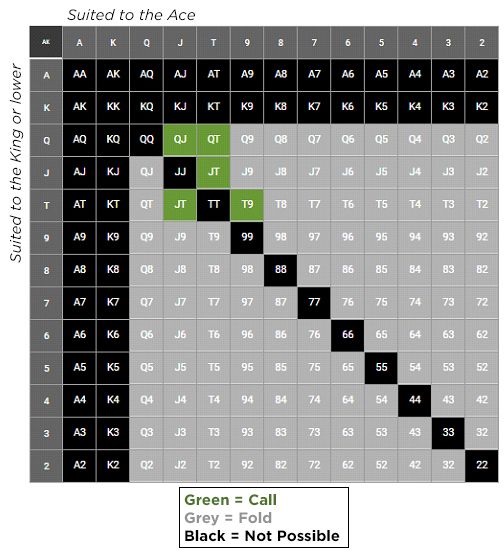Omaha Strategy Starting Hands
The very best PLO8 and O8 starting hands are known as ‘suited babies’, that is to say small suited cards with an ace suited with at least one other card. These hands have. The best starting hands in Omaha Hi Lo include: 1. The top 5 Pot-Limit Omaha strategy tips we would give for a new PLO player are: Choose your starting hands carefully and aim to play in position. Table select carefully and only play in games where you have an edge. Don’t overplay unsuited aces or other good-looking unsuited hands. The strategy for Omaha poker starting hands with King and Queen Pairs have similar rules as ace pairs. In other words, starting hands with kings and queens are as good as having ace starting hands. The best starting hands here are those clubbed with another big pair like Kd-Ks-Qd-Qs, which is.
- Omaha Strategy Starting Hands
- Omaha Starting Hand Rankings
- Omaha Hi Lo Strategy Starting Hands
- Omaha Strategy Starting Hands
Omaha Hi-Lo is a fascinating game packed with action! The action, at least in small-middle stakes games, is not only loose but many times also weak. By having four cards, and playing for high and low, some players frequently find a “reason” to stick with their hand. However, even if their hand has some potential, pot odds often do not justify playing it. So, many novice players play too loosely, stick with their hands when they shouldn’t, and end up making many mistakes.
Most errors originate from poor preflop hand selection. Understanding which Omaha high-low starting hands are solid and under which circumstances they are playable will significantly improve your game!
Starting hands
The best starting hands in Omaha hi-lo have both strong high and low potential. Since aces are the best cards for high and low, they are excellent starting hands! Almost all playable starting hands contain at least an ace! On the counterpart, cards between six and nine, are considered weak. So, any starting hand containing one or more of these cards usually decreases in value.
Another deal-breaker is to have trips in your starting hand! This is because you can only use two out of three, so you have an unusable card in your hands. Your chances of hitting a set also decrease. Let’s take a look at the strongest starting hands.

Top hands
The best starting hand is AA23, followed by AA24. These hands have excellent high and low potential! If one, or even better, both aces are suited, the strength of the hand increases as it also has nut flush potential.
Powerful starting hands with both high and low potential
- AA, with one or two low cards (the smaller, the better), like AA2x or AA35
- A2 or A3 with two high cards, like AKJ2 or AKQ3
- A2 or A3, with a big pair, like KK or QQ
Strong only low starting hands

- A2 or A3 with one or two more low cards (the lower, the better), like A23x
- 2345, 2346, 2356 (the flop must contain an ace, and at least another small card, or the hand may become useless)
Note that if one or no low cards come on the flop, these hands lose their value
Strong only high starting hands
- AA, with two high cards, like AAKJ
- A with three cards ten or higher, like AKJ10 or AKQJ
- Four high connected cards, like KQJ10 or QJ109
- High cards with one pair, like KKQJ, or KQQJ
- Double paired high cards, like KKQQ
Note that if three or even two low cards appear on the flop, these hands go down in value. So you should adjust your play accordingly.
Trouble starting hands to avoid
Unlike Holdem, in Omaha hi-lo, it is ok to play a little looser preflop. The idea is to try to see many flops with hands that have potential. However, you must remain selective and avoid some trouble hands, especially when playing in a full table.
Some hands may seem attractive, but will only make second or third best! Don’t play them as they have a negative expected value. For example, avoid playing A4x or A5x type of hands in a full table, as they may get you in trouble more often than not.
The same goes for the high. With everyone having four cards, it is more probable that someone will make a monster hand, so you don’t want to be drawing for second or third best! For example, if you are drawing for a queen-high flush, you will often lose to an ace or king-high flush. Even if you make a set of nines, you will often end up second best to a higher set! Let’ take a look at some other trap hands.
- 333A, AAA4 type hands have minimal high potential, and even if they make a low, it may be second-best.
- 9876, 8765, 7654 may seem keen but are really not! With these hands, it is tough to scoop the pot. If you make a nut straight, most of the time, there will be a low, and you will split the pot. If you make a straight with high cards, a better straight may beat you!
- High pairs with two one or two trash cards like KK9x or QQxx are weak hands. Do not confuse with the value of a pocket pair in Holdem. In Omaha hi-lo, with straight and flushes appearing often, a single pair is not all that great.

So, how to bet preflop?
In Omaha hi-lo, taking the lead in the hand with preflop aggression is less crucial than in Holdem. So, raise preflop mostly for value when you have powerful hands and position.
From position, when several players have limped, you can widen your range and add in see cheap flops with some speculative hands. Raise with premium hands for value. Most of the limpers will call you, and you also want to build the pot to be able to make big bets after the flop.
Out of position, limp with hands that have both high and low potential, to see a multiway flop.

Multiplayer versus heads-up preflop requirements
Some of the hands that are not good enough for a multiway pot go up in value heads-up. When playing in a multiway pot, you want your hand to have nut, or close to nut potential for the high and low. When playing heads up, you can win the low or high with medium-strength hands. For example, heads-up A4 is often good enough for the low, whereas in a multiway pot, it is a weak hand.
Also, heads-up you can win the high with a hand like two pair or a set, even when the board has some flush or straight possibilities. If the board is dry, even top pair-top kicker can win you the pot! In a multiplayer pot, when the board has flush or straight potential, you should expect that someone will have it most of the time!
In a nutshell
In Omaha hi-lo, you often see players playing too loosely. By adopting a selective starting hand strategy, you gain a significant advantage over your opponents. In multiplayer pots, play hands that have strong high and low potential, and avoid hands that can give you second or third best!

I hope you found this post helpful. If you have any questions or suggestions that you want to share, please leave a comment below.
Best Starting Hands in Omaha Hi Lo
Omaha and Omaha Hi Lo is a much more complicated game then Hold’em simply because you have a wider range of starting hands seen by players due to the additional cards and combinations players can make. If you’ve never played Omaha and not quite sure what we’re referring to you can read our “How to Play Omaha Guide” which will help you with the basics of the game including format.
Omaha Strategy Starting Hands
Since Omaha and Omaha Hi Lo use four hole cards, it’s absolutely critical that you understand the starting hand requirements in both versions. Making poor decisions on which hands to play and which hands to fold will ultimately cost you your bankroll. Although you’ll find plenty of beginners do end up falling for some of the more common omaha myths when choosing their starting hands.
Below you will find general outline to the starting hand requirements in Omaha Hi Lo. Omaha Hi Lo allows you to play for both the hi and low pot and because of this the starting hand requirements in Omaha 8 vary significantly from Omaha Hi since the goal is to be able to play for and win both pots. The starting hands below are dependent on situation, although you may not be able to bluff your way through this game, you can pick up a few additional big blinds through position and restricting your starting hands. Remember two things – the game is made up by strong hands and you need to play for both pots if you plan on coming out ahead.
Premium Starting Hands in Omaha High-Lo
The best starting hands in Omaha Hi Lo include:
1. A-A-2-x
2. A-A-3-x
3. A-2-3-x
4. A-2-4-x
5. A-2-x-x
6. A-3-4-x
7. A-A-x-x
While the chart above gives you a general outline of the best starting hands in Omaha Hi Lo, you do need to realize that it is still quite broad as the ‘x’ represents nearly any other card. A suited hand is significantly stronger than a non-suited hand even if they both fall in the same category. Suppose you have the option to play A-A-Q-K rainbow or A-A-2-K suited. The obvious choice of hand would be the later since your able to play for high and low, while giving you a chance at a flush, full house, or straight for hi hands. A tip to keep in mind when determining your hand strength in Omaha Hi Lo using the chart above is that the majority of cards 5 – 9 are essentially worthless. They can be used to pick up a few blinds when in position or playing against a loose table.
Omaha Starting Hand Rankings
Ten of the Best Starting Hands in Omaha High-Low
These hands are considered the top hands in Omaha Hi Lo:
Omaha Hi Lo Strategy Starting Hands
1. A-A-2-3 Double-suited
2. A-A-2-4 Double-suited
3. A-A-2-3 Suited
4. A-A-2-5 Double-suited
5. A-A-2-4 Suited
6. A-A-3-4 Double-suited
7. A-A-2-3 Non-suited
8. A-A-2-2 Double-suited
9. A-A-3-5 Double-suited
10. A-A-2-6 Double-suited
Playable Starting Hands in Omaha High-Low
Below is a summary of hands that are playable starting hands in Omaha Hi Lo
Omaha Strategy Starting Hands
A-A-2-x
A-A-3-x
A-A-4-5
A-2-3-x
A-2-K-K
A-2-Q-Q
A-2-J-J
A-3-4-5
A-A-x-x
A-2-K-Q
A-2-K-J
A-2-x-x (suited Ace)
A-3-K-K
A-3-4-x
2-3-4-5 (This hand is dependent on the Ace hitting the flop. If the flop doesn’t show an Ace you should fold)
J-Q-K-A
T-J-Q-K
K-K-Q-J
Q-J-T-9
2-3-4-x (Another hand that depends on the Ace. If no Ace hits the flop, fold the hand on first bet).